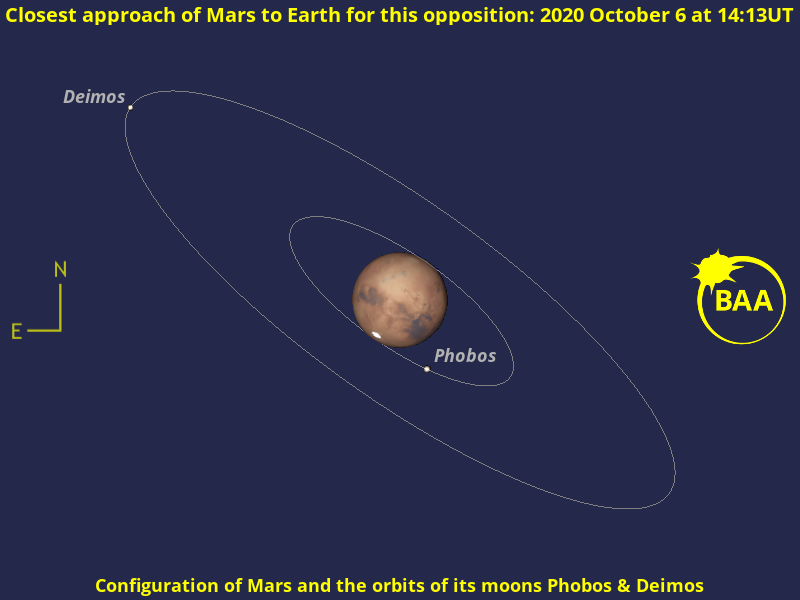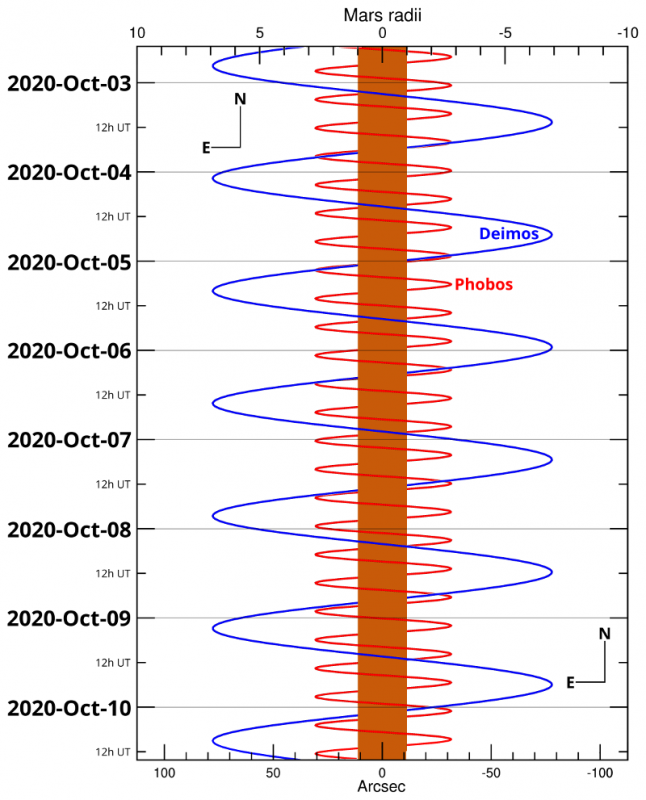2020 October 3
Martian moons at the Red Planet’s closest approach

Mars is fast approaching the point of least separation from Earth for this apparition, so the window of opportunity for viewing or imaging its tiny moons Phobos and Deimos is upon us. This is a follow-up to Richard McKim’s call to arms with the September 1 BAA Observer’s Challenge – Hunting the moons of Mars, so it’s important to read that article first for the tips and techniques contained therein if you haven’t done so already.
Finding ‘Fear’ and ‘terror’
Named after the mythological twin sons of Ares, the Greek god of war, Phobos (meaning fear) and Deimos (terror) are small and asteroid-like. Potato-shaped Phobos is the larger of the two some 27 × 22 × 18 kilometres in size, orbiting just 6,000 kilometres above the surface of Mars once every 7⅔ hours. Deimos measures 15 × 12 × 11 kilometres, orbiting Mars at an average distance of 23,460 kilometres every 30⅓ hours. The orbit of each moon is inclined by about 1° to Mars’s equator.
Since the disc of Mars is at around 700,000 times brighter than its faintest moon, Deimos, the extreme challenge lies in detecting the dim specks of light amid the glare of their parent planet. An unobstructed aperture telescope is clearly the instrument of choice. If using a Newtonian or classical/RC Cassegrain, you may need to rotate the tube to ensure that the diffraction spike from the secondary mirror support doesn’t obscure a moon. Clean and collimated optics are a must.
Note: see Web apps depicting Mars and its moons below for observations of Phobos and Deimos after October 10, or click here to go directly to the Martian Moons web app, valid until the end of November 2020.

Orbits and elongations diagram
The accompanying infographic depicting Mars and the orbits of Phobos and Deimos covers an eight-day period centred on the Red Planet’s closest approach to Earth. Time increases from the top down with dates and Universal Times read from the scale on the left. (Click the graphic, or here, to open a larger version in a new window suitable for printing.) The central orange column represents the disc of Mars, while the helical red and blue lines represent the paths of Phobos and Deimos, respectively.
You can see that the interval between successive easterly or westerly elongations of Phobos is around 7⅔ hours, or 30⅓ hours for Deimos. Note: while transits and occultations of Phobos by Mars do occur until October 11, those instances when a moon’s path appears to pass in front of its parent planet is intended to represent when that moon lies at inferior conjunction.
The graphic is orientated with Martian north up and celestial east to the left, so users of refractors, Schmidt- and Maksutov-Cassegrains with a star diagonal need to mirror this graphic left-right to replicate what they see through the eyepiece. Observers with inverted-image Newtonian/Dobsonian telescopes, or ‘straight-through’ refractors and catadioptrics, should rotate the illustration through 180°.
Given that Mars reaches opposition on October 13, the infographic’s horizontal grey lines at 0h UT for each date closely correspond to the times when the planet is highest in the southern sky of the British Isles, hence elongations of Phobos or Deimos near these times are most favourable. Observers on the East Coast of North America experience favourable elongations of Phobos and Deimos near 5h UT, while elongations occurring near 8h UT favour the West Coast. For New Zealand and Australia, optimal elongations of the Martian moons occur between 12h and 16h UT.
Web apps depicting Mars and its moons
You can see which side of Mars faces Earth with Mars Mapper 2020-21, or experience an interactive version of the infographic above with Martian Moons 2020. Note that the second app shows observational data for Phobos and Deimos from September until the end of November 2020.
| The British Astronomical Association supports amateur astronomers around the UK and the rest of the world. Find out more about the BAA or join us. |
